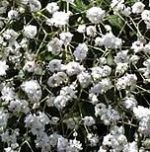 Baby’s breath is a herbaceous perennial native to central and eastern Europe and central and western Asia but naturalized in North America and is now considered invasive from new Brunswick to British Columbia, south to Pennsylvania, Oklahoma, and California where it grows in grasslands, dunes, abandon fields, ditches and other open areas. Plants grow 2-4′ tall from a deep root system and have highly branched stems with swollen leaf nodes. The gray-green leaves are narrow and up to 4″ long. The white bell-shaped flowers are 1/4- 1/8″ wide and have 5 petals. A single plant can produce up to 13,700 seeds in a year and once established can quickly spread. Plants like full sun and medium dry, well-drained, basic (7.0-7.5) soil in USDA Hardiness Zones 3-9
Baby’s breath is a herbaceous perennial native to central and eastern Europe and central and western Asia but naturalized in North America and is now considered invasive from new Brunswick to British Columbia, south to Pennsylvania, Oklahoma, and California where it grows in grasslands, dunes, abandon fields, ditches and other open areas. Plants grow 2-4′ tall from a deep root system and have highly branched stems with swollen leaf nodes. The gray-green leaves are narrow and up to 4″ long. The white bell-shaped flowers are 1/4- 1/8″ wide and have 5 petals. A single plant can produce up to 13,700 seeds in a year and once established can quickly spread. Plants like full sun and medium dry, well-drained, basic (7.0-7.5) soil in USDA Hardiness Zones 3-9
Pine-leaf Milkweed (Ascleipas linaria)
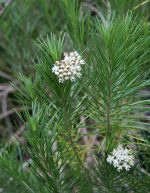 Also called pine-needle milkweed, this evergreen herbaceous perennial or subshrub is native to Arizona, New Mexico, and the southern most part of California where it grows on dry rocky slopes, ridges, mesas, in canyons, and oak pine juniper woodland. Plants grow up to 5′ tall, but usually 2-3′ tall, and have milky sap and branched reddish stems that become woody from the bottom up with age. The narrow green leaves are sessile, dense, alternately or spirally arranged, and resemble pine needles, hence the common names pine-leaf/needle milkweed. From February to December subterminal and lateral .75-1.5″ wide umbels of 10 or more small white flowers appear. Each flower has reflexed petals surrounding pink or purplish tipped rounded hoods with horns attached at the center. The fruit is a tear-shaped follicle containing many plumed seeds. USDA Hardiness Zones 9-11. Photo Credit: Wikipedia
Also called pine-needle milkweed, this evergreen herbaceous perennial or subshrub is native to Arizona, New Mexico, and the southern most part of California where it grows on dry rocky slopes, ridges, mesas, in canyons, and oak pine juniper woodland. Plants grow up to 5′ tall, but usually 2-3′ tall, and have milky sap and branched reddish stems that become woody from the bottom up with age. The narrow green leaves are sessile, dense, alternately or spirally arranged, and resemble pine needles, hence the common names pine-leaf/needle milkweed. From February to December subterminal and lateral .75-1.5″ wide umbels of 10 or more small white flowers appear. Each flower has reflexed petals surrounding pink or purplish tipped rounded hoods with horns attached at the center. The fruit is a tear-shaped follicle containing many plumed seeds. USDA Hardiness Zones 9-11. Photo Credit: Wikipedia
Rocky Mountain Bee Plant (Cleome serrulata)
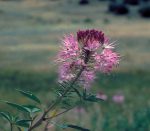 Rocky Mountain bee plant is an annual native to western North America where it grows in prairies, open woods and disturbed sites from southern British Columbia, east to Minnesota, and south to Arizona and New Mexico. Plants grow 4-5′ tall and have a leafy branched stem bearing palmately compound leaves with 3 leaflets. From May to September the flowers appear in terminal racemes. Each nectar filled flower has 4 white to pink or purple petals and six 3″ long stamens that protrude beyond the petals. The cluster of flowers continue to elongate during the season so flowers and 4″ long thin drooping seed pods appear together and have a light airy spidery look. Photo Credit: Wikipedia
Rocky Mountain bee plant is an annual native to western North America where it grows in prairies, open woods and disturbed sites from southern British Columbia, east to Minnesota, and south to Arizona and New Mexico. Plants grow 4-5′ tall and have a leafy branched stem bearing palmately compound leaves with 3 leaflets. From May to September the flowers appear in terminal racemes. Each nectar filled flower has 4 white to pink or purple petals and six 3″ long stamens that protrude beyond the petals. The cluster of flowers continue to elongate during the season so flowers and 4″ long thin drooping seed pods appear together and have a light airy spidery look. Photo Credit: Wikipedia
Illinois Bundle Flower (Desmanthus illinoiensis)
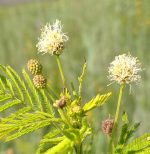 Also known as false sensitive plant and Illinois mimosa, this herbaceous perennial is native from South Dakota and Minnesota through Colorado, New Mexico and Texas, and eastward to Ohio, Kentucky, Tennessee, and the Carolinas and into Florida where it is found on prairies, moist meadows, open wooded slopes, ravines, stream banks, roadsides and waste areas. Plant grow 24-51″ tall and have a woody caudex and longitudinally mostly unbranched grooved stems. The bipinnately compound leaves are up to 8″ long and have 8-10 pairs of leaflets that are further divided into 20-40 subleaflets 1/8′ long. In July and August 3′ long lateral stalks carry 1/2″ wide globose to ovoid flowerheads that look like a starburst and consist of 25-50 densely packed flowers. Each flower has 5 white petals and 5 protruding stamens with white filaments and pale yellow anther. The flowerheads are replaced by 5-15 curved and somewhat flattened seedpods 1/2″ long and containing 2-5 reddish brown seeds. USDA Hardiness Zones 5-8. Photo Credit: Thum Yorky, Wikimedia Commons
Also known as false sensitive plant and Illinois mimosa, this herbaceous perennial is native from South Dakota and Minnesota through Colorado, New Mexico and Texas, and eastward to Ohio, Kentucky, Tennessee, and the Carolinas and into Florida where it is found on prairies, moist meadows, open wooded slopes, ravines, stream banks, roadsides and waste areas. Plant grow 24-51″ tall and have a woody caudex and longitudinally mostly unbranched grooved stems. The bipinnately compound leaves are up to 8″ long and have 8-10 pairs of leaflets that are further divided into 20-40 subleaflets 1/8′ long. In July and August 3′ long lateral stalks carry 1/2″ wide globose to ovoid flowerheads that look like a starburst and consist of 25-50 densely packed flowers. Each flower has 5 white petals and 5 protruding stamens with white filaments and pale yellow anther. The flowerheads are replaced by 5-15 curved and somewhat flattened seedpods 1/2″ long and containing 2-5 reddish brown seeds. USDA Hardiness Zones 5-8. Photo Credit: Thum Yorky, Wikimedia Commons
California Internal Buckwheat (Eriogonum fasciculatum var. polifolium)
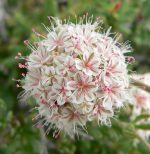 Also known as eastern Mojave buckwheat, this rounded evergreen shrub or subshrub is native to western North America from Utah to California, south to Arizona and Mexico where it grows on dry slopes and washes, and in canyons of deserts areas and coastal foothills. Plants grow 2-3′ tall and have gray hairy leaves up to .25″ long that may drop in the summer. From spring to summer dense flowerheads of creamy white flowers appear on long stems and turn deep brown in the fall. Each 6 petaled flower has protruding rose tipped stamens that give the appearance of whiskers. Flowers are attractive to bees and butterflies. USDA Hardiness Zones 7-10. Photo Credit Wikipedia
Also known as eastern Mojave buckwheat, this rounded evergreen shrub or subshrub is native to western North America from Utah to California, south to Arizona and Mexico where it grows on dry slopes and washes, and in canyons of deserts areas and coastal foothills. Plants grow 2-3′ tall and have gray hairy leaves up to .25″ long that may drop in the summer. From spring to summer dense flowerheads of creamy white flowers appear on long stems and turn deep brown in the fall. Each 6 petaled flower has protruding rose tipped stamens that give the appearance of whiskers. Flowers are attractive to bees and butterflies. USDA Hardiness Zones 7-10. Photo Credit Wikipedia
Flowering Spurge (Euphorbia corollata)
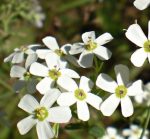 Also called prairie baby’s breath, flowering spurge is a herbaceous perennial native to North America from Texas north to South Dakota and east to the Atlantic coast where it grows in open woodlands, prairies, pastures, glades, abandon fields, mined lands, and in waste areas such as along roadsides and railroad train tracks. Growing from a deep tap root, flowering spurge is 1-3′ feet tall and has smooth light green stems that are branched at the top. The oblong leaves are gray-green to green, , up to 2 1/2 inches long, and alternate to the top where they form a whorl of three or more around the inflorescence. Both leaves and stem contain a white latex that may cause skin and eye irritation. The male and female flowers are 1/4″ across and lack petals but have white petaloid bracts, and are carried on the same plant in loose terminal panicles up to 1″ across. They bloom throughout the summer and the female flowers give way to three sided capsules. Plants spread by seed and short rhizomes and can become weedy. USDA Hardiness Zones 3-9.
Also called prairie baby’s breath, flowering spurge is a herbaceous perennial native to North America from Texas north to South Dakota and east to the Atlantic coast where it grows in open woodlands, prairies, pastures, glades, abandon fields, mined lands, and in waste areas such as along roadsides and railroad train tracks. Growing from a deep tap root, flowering spurge is 1-3′ feet tall and has smooth light green stems that are branched at the top. The oblong leaves are gray-green to green, , up to 2 1/2 inches long, and alternate to the top where they form a whorl of three or more around the inflorescence. Both leaves and stem contain a white latex that may cause skin and eye irritation. The male and female flowers are 1/4″ across and lack petals but have white petaloid bracts, and are carried on the same plant in loose terminal panicles up to 1″ across. They bloom throughout the summer and the female flowers give way to three sided capsules. Plants spread by seed and short rhizomes and can become weedy. USDA Hardiness Zones 3-9.
Winterfat (Krascheninnikovia lanata, aka Ceratoides lanata)
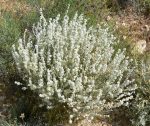 This long-lived evergreen small shrub is native to western North America from Saskatchewan to Washington, south to Texas and California into Mexico where it grows in dry plains, xeric scrublands, dry valley bottoms, mesas and in salty soils such as those of the alkali flats in the Great Basin, Central Valley, Great Plains, and Mojave Desert. Plants grow up to 4′ tall from a long taproot with lateral branches and have flexible stems covered with dense white hairs and carrying small, woolly blue-green linear leaves that become reddish with age. From early spring to summer, dense terminal and axillary spikes of inconspicuous apetalous male and female flowers appear. The male flowers have large woolly leaf like bracts while the female flowers have small bracts and produce tiny white seeds with silky white hairs during the fall. USDA Hardiness Zones 6-9. Photo Credit: Wikipedia
This long-lived evergreen small shrub is native to western North America from Saskatchewan to Washington, south to Texas and California into Mexico where it grows in dry plains, xeric scrublands, dry valley bottoms, mesas and in salty soils such as those of the alkali flats in the Great Basin, Central Valley, Great Plains, and Mojave Desert. Plants grow up to 4′ tall from a long taproot with lateral branches and have flexible stems covered with dense white hairs and carrying small, woolly blue-green linear leaves that become reddish with age. From early spring to summer, dense terminal and axillary spikes of inconspicuous apetalous male and female flowers appear. The male flowers have large woolly leaf like bracts while the female flowers have small bracts and produce tiny white seeds with silky white hairs during the fall. USDA Hardiness Zones 6-9. Photo Credit: Wikipedia
California sea lavender (Limonium californica,)
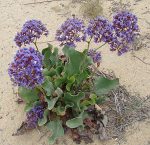 This mounding evergreen herb or subshrub, also called western marsh rosemary, is native to western US from Oregon to California where it grows in coastal habitats such as salt marshes, prairies, and dunes. Plants grow from a rhizomatous fibrous root system and have a woody caudex that produces a basal rosette of oval, thick leathery leaves up to 12″ long and with sunken salt glands on their underside. From summer to fall terminal clusters of flowers appear on stiff branched panicles up to 14″ long. Each flower has 5 white to pale lavender petals and 5 brownish white ribbed sepals. USDA Hardiness Zones 8-10. Photo Credit: Wikipedia
This mounding evergreen herb or subshrub, also called western marsh rosemary, is native to western US from Oregon to California where it grows in coastal habitats such as salt marshes, prairies, and dunes. Plants grow from a rhizomatous fibrous root system and have a woody caudex that produces a basal rosette of oval, thick leathery leaves up to 12″ long and with sunken salt glands on their underside. From summer to fall terminal clusters of flowers appear on stiff branched panicles up to 14″ long. Each flower has 5 white to pale lavender petals and 5 brownish white ribbed sepals. USDA Hardiness Zones 8-10. Photo Credit: Wikipedia
India Physic (Porteranthus trifoliatus aka Gillenia trifoliata)
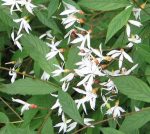 Also called fawn’s breath, bowman’s root and American ipecac, this clump-forming herbaceous perennial is native to eastern North America from Ontario and New England, south to Georgia, Kentucky, and Alabama where it grows in open upland woods and clearings, rocky slopes, and roadsides, mostly in the mountains. Plants grow 2-3′ tall from a woody rootstock and have compound leaves with 3 oblong toothed leaflets up to 4″ long. The leaflets are olive green until fall when they turn bronzy red. From late spring to summer the wiry branching reddish stems carry loose panicles of white to pink flowers. Each star-like flower is 1″ across and has 5 narrow petals and a red calyx that persists into fall after petal drop. USDA Hardiness Zones 4-8
Also called fawn’s breath, bowman’s root and American ipecac, this clump-forming herbaceous perennial is native to eastern North America from Ontario and New England, south to Georgia, Kentucky, and Alabama where it grows in open upland woods and clearings, rocky slopes, and roadsides, mostly in the mountains. Plants grow 2-3′ tall from a woody rootstock and have compound leaves with 3 oblong toothed leaflets up to 4″ long. The leaflets are olive green until fall when they turn bronzy red. From late spring to summer the wiry branching reddish stems carry loose panicles of white to pink flowers. Each star-like flower is 1″ across and has 5 narrow petals and a red calyx that persists into fall after petal drop. USDA Hardiness Zones 4-8
Heath Aster (Symphyotrichum ericoides aka Aster ericoides)
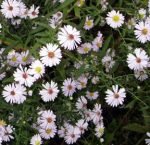 This herbaceous perennial is native to central and eastern US from main to manitoba, south to Pennsyvania and New Mexico where it grows in open areas including roadways and railroads. The compact bushy plants spread by rhizomes and form loose colonies but can become invasive in the right conditions. The much-branched stems carry stiff, lance-shaped, sessile leaves that are one to three inch long. The leaves resemble those of heather (Erica) giving rise to the common name and specific epithet (ericoides). A multitude of daisy-like flowerheads ½ inch across appear in late summer to fall on stiff terminal and side branches often in one-sided racemes. Each flowerhead is composed of central yellow disc flowers surrounded by ray flowers that are white, sometimes light blue or pink. USDA Hardiness Zones 3-10
This herbaceous perennial is native to central and eastern US from main to manitoba, south to Pennsyvania and New Mexico where it grows in open areas including roadways and railroads. The compact bushy plants spread by rhizomes and form loose colonies but can become invasive in the right conditions. The much-branched stems carry stiff, lance-shaped, sessile leaves that are one to three inch long. The leaves resemble those of heather (Erica) giving rise to the common name and specific epithet (ericoides). A multitude of daisy-like flowerheads ½ inch across appear in late summer to fall on stiff terminal and side branches often in one-sided racemes. Each flowerhead is composed of central yellow disc flowers surrounded by ray flowers that are white, sometimes light blue or pink. USDA Hardiness Zones 3-10